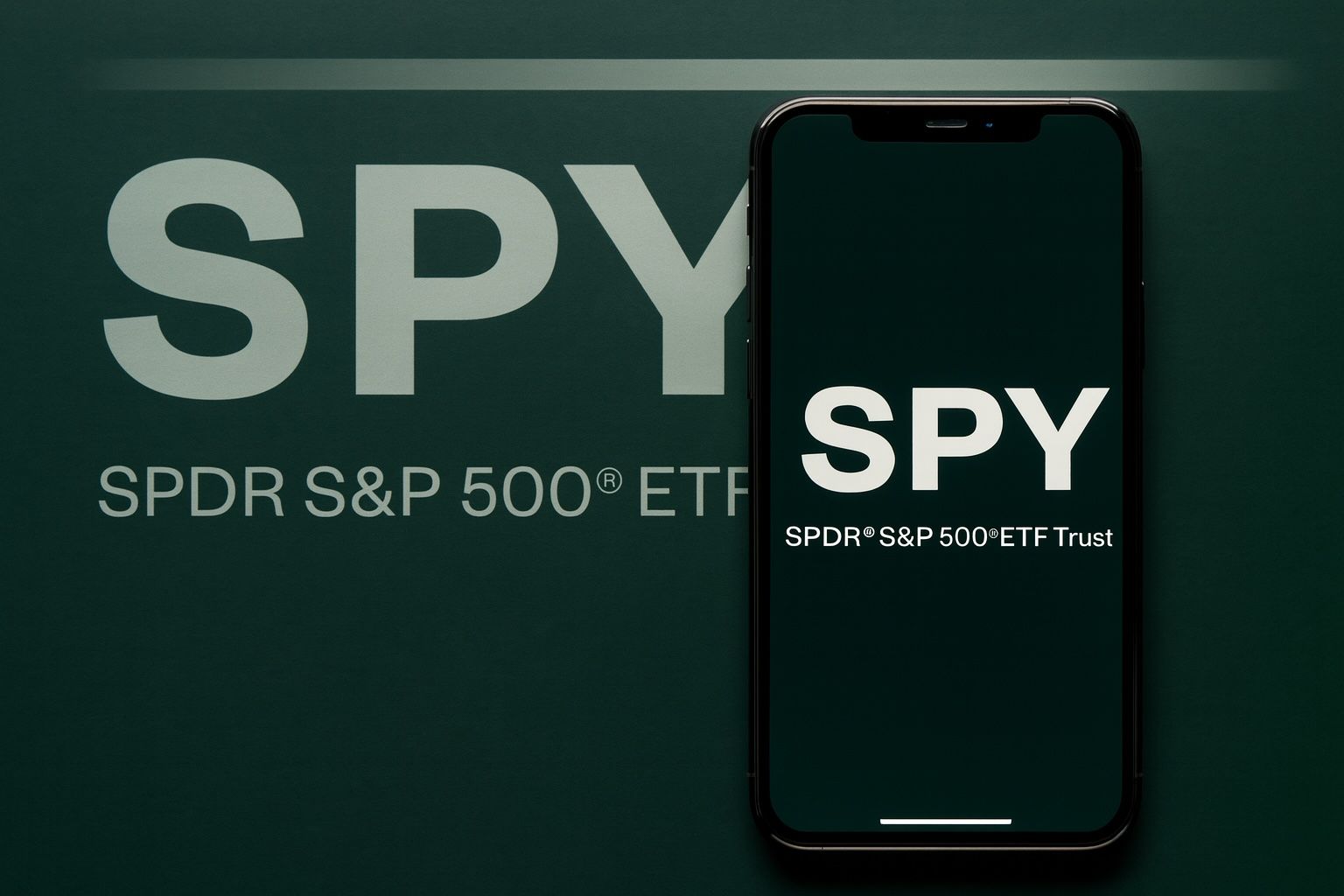U.S. stocks started the new week under pressure, and the SPDR S&P 500 ETF Trust (ticker: SPY) – the world’s largest ETF and a bellwether for the U.S. equity market – moved lower with them on Monday, November 17, 2025.
SPY slipped roughly 0.9%, tracking the S&P 500 index’s 0.9–0.92% decline as all three major U.S. benchmarks finished solidly in the red. The Dow Jones Industrial Average lost about 1.2%, the S&P 500 fell to around 6,672, and the Nasdaq Composite dropped roughly 0.8–0.9%. [1]
Investors are juggling several big storylines at once: Nvidia’s earnings report on Wednesday, a long-delayed U.S. jobs report after the recent government shutdown, and a fresh round of commentary from Federal Reserve officials about the path of interest rates. [2]
SPY stock today: price action at a glance
Based on late-session data, SPY traded in the mid‑$660s to mid‑$670s on Monday, with a loss of about 0.9–0.93% on the day. [3]
Key intraday stats for November 17, 2025 (NYSE Arca):
- Open: around $669–670
- Intraday high: roughly $676
- Intraday low: around $662
- Last trade (late session): about $666
- Volume: close to 89 million shares, above SPY’s three‑month average of ~75 million shares. [4]
A separate daily update from TipRanks also reports that SPY declined 0.93% on Monday, emphasizing that the weakness was tied to pressure in key technology holdings and caution around Nvidia’s upcoming earnings. [5]
Sector drivers: tech drag vs. defensive pockets of strength
Under the hood, Monday’s move in SPY was far from uniform across sectors.
Data from TipRanks’ SPY ETF Daily Update highlights that: [6]
- Gaining sectors inside SPY:
- Communication Services
- Utilities
- Declining sectors:
- Materials
- Financials
- Energy
- Technology
- Industrials
This pattern fits the broader market narrative: investors cautiously rotated toward more defensive, cash‑flow‑oriented sectors while trimming exposure to economically sensitive cyclicals and richly valued tech names.
Macro backdrop: shutdown hangover, data deluge and Fed uncertainty
Monday’s drop didn’t happen in a vacuum. Wall Street is digesting the aftermath of the longest U.S. government shutdown on record, which temporarily halted key economic data releases and complicated the Federal Reserve’s policy calculus. [7]
With the shutdown now over, this week is packed with “catch‑up” data, including: [8]
- The September U.S. employment report, due Thursday
- Other delayed inflation and activity indicators
- The FOMC minutes from the last policy meeting
At the same time, Fed officials are sending mixed but generally cautious signals:
- In a speech titled “The Case for Continuing Rate Cuts” delivered in London on November 17, Fed Governor Christopher Waller argued that slowing growth, a weakening labor market and inflation drifting closer to the Fed’s 2% target justify another policy rate cut at the December 9–10 meeting. [9]
- Yet market-based pricing tells a more skeptical story: according to reporting that cites the CME FedWatch tool, traders now see less than a 50% chance of a December cut, down from higher odds just two weeks ago, as persistent 3% inflation keeps the Fed cautious. [10]
For SPY holders, that tug‑of‑war matters. A dovish Fed tilt typically supports equity valuations and broad index ETFs, while “higher for longer” interest‑rate expectations increase the discount rate investors use to value future earnings, especially in long‑duration, growth‑heavy sectors like tech.
AI jitters and Nvidia’s earnings keep markets on edge
The AI trade remains central to SPY’s fate. Nvidia, now the largest company in the world by market value and a heavyweight in the S&P 500, will report Q3 FY2026 earnings on Wednesday, November 19, after the U.S. market close. [11]
Ahead of those results:
- Reuters notes that Nvidia shares fell about 1.9% on Monday, making them one of the biggest drags on both the S&P 500 and Nasdaq. [12]
- Analysts expect sharp volatility around the earnings release, as markets look for any sign that AI‑related demand is slowing after an extraordinary multi‑year run. [13]
More broadly, coverage from ABC News emphasizes that investors are re‑evaluating whether massive AI spending on data centers will translate into profits fast enough to justify today’s sky‑high valuations. [14]
Even so, not all mega‑caps were under pressure:
- Alphabet (Google) jumped about 3% on Monday after Berkshire Hathaway disclosed a new stake of roughly $4.3 billion, making the stock one of the day’s notable gainers in the S&P 500. [15]
- Apple, by contrast, fell nearly 1.8% as Berkshire continued trimming its long‑held position. [16]
That mix – one AI bellwether sliding, another mega‑cap surging thanks to Warren Buffett’s seal of approval – helped keep SPY under pressure but cushioned it from an even deeper sell‑off.
Retail investors cool on “buy the dip”
One of the most important shifts for SPY is happening not in the index itself, but in who is buying it.
A Reuters analysis on November 17 found that retail investors are showing less conviction in buying U.S. stock market dips, after playing a huge role in powering the market’s rally and repeated rebounds from earlier sell‑offs. [17]
Key takeaways from that report:
- Vanda Research says retail buyers are no longer displaying the same high‑conviction dip‑buying that fueled big rallies earlier in the year. Recent down days saw some of the weakest retail ETF buying of 2025. [18]
- Over the summer, individual investors shifted toward broad-market ETFs like SPY and QQQ as a “safety blanket”, but late last week they even started scaling back purchases of those ETFs. [19]
- BofA Securities reports that retail investors were net sellers of U.S. equities for the first time since late September, leaving institutional investors to do most of the recent ETF buying. [20]
Because SPY is often the default vehicle for U.S. equity exposure, a cooling in retail enthusiasm can make intraday swings sharper: fewer dip‑buyers can mean weaker support on down moves, especially when macro headlines are negative.
Flows, positioning and sentiment around SPY
Despite the cautious tone, positioning data still show significant institutional and retail interest in SPY:
- TipRanks reports that SPY’s 5‑day net inflows totaled about $1 billion, indicating net new capital has moved into the ETF over the past week, even as prices have wobbled. [21]
- Retail sentiment on SPY screens as positive, and hedge funds have increased their SPY exposure over the latest quarter, according to aggregated positioning metrics. [22]
- A separate analysis of recent 13F filings shows that both SPY and the iShares Core S&P 500 ETF (IVV) were among the 25 most aggressively bought positions by large hedge funds in Q3, suggesting a renewed preference for broad, diversified index exposure rather than single‑stock bets. [23]
- Within the ETF industry, research highlighted by WealthManagement notes that the U.S. ETF market has split into distinct price‑based segments, but that SPY often enjoys a sizable seasonal inflow surge near year‑end, which could help State Street reclaim market‑share leadership. [24]
From a sentiment standpoint, TipRanks’ “ETF AI Analyst” aggregates analyst ratings on SPY’s underlying holdings and currently tags the fund as a “Moderate Buy”, with an average implied price target pointing to high‑teens percentage upside from current levels. [25]
That doesn’t guarantee anything – but it underscores how, even on a down day, Wall Street positioning remains broadly constructive on the S&P 500 via SPY.
Technical picture: key SPY levels traders are watching
Short‑term traders also paid close attention to SPY’s technical levels on Monday.
According to TheFly’s pivot‑point report, DeMark‑based calculations put SPY’s: [26]
- Pivot high: about $679.99
- Pivot low: about $667.60
Price sliding into – and briefly below – that pivot zone adds to the near‑term bearish tone, especially as the broader S&P 500 and Nasdaq both closed below their 50‑day moving averages for the first time since late April, a widely watched indicator of the intermediate‑term trend. [27]
For context:
- SPY remains well above its 52‑week low and, like the S&P 500, is still up double‑digits year‑to‑date despite November’s pullback. ABC News notes that even after the recent slide, the S&P 500 is up about 15% in 2025, while the Nasdaq has gained roughly 19% and the Dow about 11% year to date. [28]
In other words, Monday’s move looks more like a notable correction within an ongoing uptrend than a confirmed trend reversal – but the technical picture is clearly less forgiving than it was just a few weeks ago.
Long‑term perspective: SPY’s track record still looms large
For longer‑horizon investors, days like November 17 can feel noisy against SPY’s multi‑decade track record.
As a reminder:
- SPY is designed to mirror the performance of the S&P 500 index before fees, giving investors exposure to 500 leading U.S. companies across all 11 GICS sectors. [29]
- Over the last decade, SPY’s total return has been substantial; one recent analysis estimated that a $1,000 investment 10 years ago would have grown to nearly four times that amount, including reinvested dividends. [30]
Past performance never guarantees future results, but this history is exactly why SPY remains a core building block for many portfolios, even when short‑term sentiment turns cautious.
What to watch next if you follow SPY
If you’re tracking SPY this week, here are the key catalysts likely to influence the ETF’s day‑to‑day moves:
- Nvidia earnings (Wednesday, Nov. 19)
The single most important company‑level event, given Nvidia’s weight in the index and its central role in the AI trade. [31] - U.S. September jobs report (Thursday)
The first full employment report after the shutdown, and a crucial input into the Fed’s December rate decision. [32] - Big‑box retailer earnings
Results from Walmart, Home Depot, Target and others will offer a real‑time read on consumer spending, which drives roughly 70% of U.S. GDP. [33] - Fresh Fed commentary & market-implied rate odds
Any shift in tone from Fed officials – especially around the “case for continuing rate cuts” vs. patience – could quickly affect expectations and thus index valuations. [34] - Retail and hedge‑fund flows into SPY and its peers
Whether retail investors resume dip‑buying in SPY, or continue to step back while hedge funds add exposure, will shape how responsive the ETF is to good or bad headlines. [35]
Bottom line
On November 17, 2025, SPY reflected a market that is nervous but not panicked:
- The ETF fell about 0.9% as investors de‑risked ahead of Nvidia earnings and a wave of delayed economic data. [36]
- Tech and cyclicals weighed on performance, while a handful of more defensive sectors and individual winners like Alphabet provided some offset. [37]
- Retail dip‑buying is moderating, even as hedge funds and institutions continue to lean into broad S&P 500 exposure. [38]
- The Fed narrative is in flux, with some policymakers calling for continued rate cuts and markets increasingly uncertain about how dovish December will really be. [39]
For readers and investors, the message from SPY today is less about a looming crisis and more about a market entering a more finely balanced, data‑dependent phase: short‑term swings may stay choppy, but the long‑term case for broad U.S. equity exposure via SPY remains anchored in earnings, diversification and history rather than any single day’s move.
Disclaimer:
This article is for informational and educational purposes only and does not constitute financial, investment or trading advice. Always do your own research and consider speaking with a licensed financial professional before making investment decisions.
References
1. www.reuters.com, 2. www.reuters.com, 3. stockanalysis.com, 4. www.tipranks.com, 5. www.tipranks.com, 6. www.tipranks.com, 7. www.reuters.com, 8. www.reuters.com, 9. www.federalreserve.gov, 10. abcnews.go.com, 11. m.economictimes.com, 12. www.reuters.com, 13. m.economictimes.com, 14. abcnews.go.com, 15. www.reuters.com, 16. www.reuters.com, 17. www.reuters.com, 18. www.reuters.com, 19. www.reuters.com, 20. www.reuters.com, 21. www.tipranks.com, 22. www.tipranks.com, 23. www.benzinga.com, 24. www.wealthmanagement.com, 25. www.tipranks.com, 26. www.tipranks.com, 27. www.reuters.com, 28. abcnews.go.com, 29. www.ssga.com, 30. www.nasdaq.com, 31. m.economictimes.com, 32. www.reuters.com, 33. www.reuters.com, 34. www.federalreserve.gov, 35. www.reuters.com, 36. www.reuters.com, 37. www.tipranks.com, 38. www.reuters.com, 39. www.federalreserve.gov








